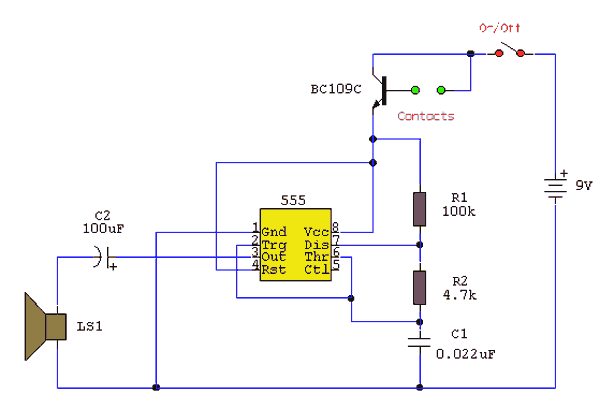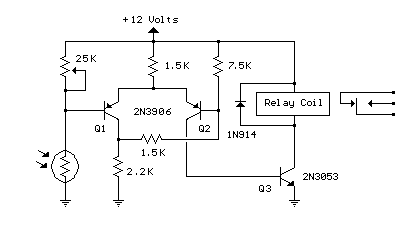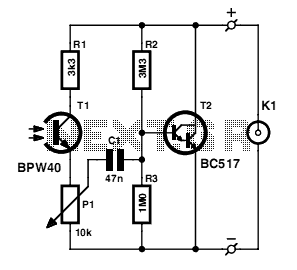
Lightning Activated Camera Shutter Trigger

This circuit is designed to trigger a camera's electronic shutter when a flash of lightning occurs. It can also be used for capturing fireworks displays or other events with brief light bursts. The photo darlington component converts light pulses into electrical signals. The first section of the LM324 amplifies these electrical pulses, while the second section acts as a high-pass filter, allowing only rapid changes (such as lightning) to pass through. The third LM324 stage serves as a comparator, permitting only significant pulses to be transmitted. The 4047 one-shot circuit elongates the pulse duration to ensure it is sufficient to activate the relay and trigger the camera. The 2N3904 transistor drives the reed relay, which in turn activates the camera's electronic shutter switch. The VN10KM component prevents the circuit from inadvertently triggering the camera upon initial power-up. The LM324 ground reference circuit divides the 9V power supply into two for a 4.5V ground reference, which is utilized by the other op-amp circuits. The original photodarlington transistor used was the QT semiconductor model QT-L14R1, with a similar part available from Digi-Key, the Optek OP560C (part number 365-1073-ND). The VN10KM is an N-channel MOSFET; if unavailable, a more common IRF520 or similar N-channel power MOSFET can be used. The 4047 is a standard 4000 series CMOS one-shot, available from Digi-Key as part number CD4047BCN-ND. The circuit can be assembled on a small piece of perforated circuit board using point-to-point wiring. The board should be housed in a small plastic case, preferably black. The photodarlington transistor can be mounted through a hole on the side of the case, and a small metal clip can be used to secure it to the camera's viewfinder. However, there is no standardization for viewfinder mounts among camera manufacturers. When utilizing an SLR camera, this circuit should only be employed at night, as daytime use may cause it to retrigger indefinitely due to the SLR's viewfinder changing from dark to bright when a photo is taken. For daytime applications, it may be beneficial to place the photodarlington transistor inside a black tube, cut to a length that aligns its angle of view with the camera lens setting. The rear of the tube should be covered to block light from entering. The camera must be mounted on a tripod, with the lightning trigger secured to the camera. Slower film speeds enhance the ability to capture lightning images, with ASA 100 and 200 film yielding favorable results in both color and black and white. Camera settings depend on the model used; for instance, the Nikon N2000 performs well in auto-exposure mode, while the Nikon N70 may respond too slowly, necessitating manual exposure settings with a narrow aperture and longer duration. Digital cameras are ideal for this application since they eliminate film costs; however, only high-end models typically feature external trigger inputs and may exhibit significant delays between trigger activation and photo capture. Manual exposure settings may enhance the camera's responsiveness. Reports indicate success with the Canon Digital Rebel EOS camera using this circuit. In scenarios involving large thunderstorms, lightning strikes often create a conductive path and may strike multiple times along the same route, making these strikes easier to photograph. Conversely, capturing single daytime strikes is more challenging due to the need for shorter exposure times, which reduces the likelihood of recording a lightning event. Users should be prepared to use a substantial amount of film, as a good storm can deplete a 36-exposure roll in a matter of minutes, with approximately half of the resulting images being satisfactory during nighttime photography.
This circuit employs a photodarlington configuration to detect rapid light changes, making it particularly effective for capturing transient events like lightning. The LM324 operational amplifiers are critical for signal amplification and filtering, ensuring that only significant light pulses trigger the camera. The use of a 4047 one-shot timer is essential for pulse elongation, allowing the relay to be actuated without missing the brief moments of illumination. The design emphasizes reliability, with components chosen for their availability and compatibility. The physical assembly recommendations, including the use of a black tube for daytime operation and securing the circuit to a tripod-mounted camera, enhance usability and effectiveness. Proper exposure settings are crucial for success, especially when working with different camera models and conditions. Overall, this circuit is a sophisticated solution for capturing fleeting photographic moments associated with natural phenomena.This circuit is used to trigger a camera`s electronic shutter circuit when a flash of lightning is present. This circuit would also work for photographing fireworks displays or other events involving flashes of light.
In a nutshell, the photo darlington converts light pulses into electrical pulses, the first LM324 section amplifies the electrical pulses, the second LM324 section is a high pass filter that only passes quick changes (lightning). The third LM324 stage is a comparator that allows only large pulses to pass through, and the 4047 one-shot stretches out the length of the pulses so that they are long enough to drive the relay and trigger the camera. The 2N3904 drives the reed relay, which in turn triggers the camera`s electronic shutter switch. The VN10KM prevents the circuit from triggering the camera when it is first turned on. The LM324 GND Ref circuit divides the 9V power into two for a 4. 5V ground reference. The other op-amp circuits use this reference value. The original photodarlington transistor I used was a QT semiconductor model QT-L14R1. A similar part that is available from Digi-key is the Optek OP560C, part number 365-1073-ND. The VN10KM is an N channel mosfet transistor. If a VN10KM FET cannot be found, substitute a more common IRF520 or similar N-channel power MOSFET. The 4047 is a standard 4000 series CMOS one-shot, Digi-key sells it as part number CD4047BCN-ND. The circuit can be built on a small piece of perforated circuit board using a point-to-point wiring technique.
The circuit board can be mounted inside of a small plastic case, preferably made of black plastic. The photodarlington transistor can be mounted in a hole on the side of the box, a small metal clip can be used to slide over the camera`s viewfinder. Unfortunatly, there is no standard for viewfinder mounts between camera manufacturers. When shooting through an SLR camera, this circuit should only be used at night. Daytime use will cause it to retrigger indefinitely because the SLR`s viewfinder goes black then bright when the photo is done, this restarts the detector.
For daytime use, it may be preferable to mount the photodarlington transistor in a black tube, the tube should be cut to a length that gives the transistor an angle of view that is similar to the camera lens setting. The back of the tube should be covered with something black to block light from the back side. The camera should always be set up on a tripod, the lightning trigger should be physically secured to the camera.
Slower film speeds will improve the ability to capture lightning photos. I have had good luck with ASA 100 and 200 film, both color and black and white. The camera setting depends on the model used, I have taken many good shots with a Nikon N2000 camera in auto-exposure mode. A newer Nikon N70 responds too slowly in auto-exposure mode, try using a manual exposure mode with a tight F setting and a long time duration.
A digital camera is ideal for this type of operation since you don`t have to pay for film. Unfortunately, only high end digital cameras tend to have external trigger inputs, and many suffer from a very long delay between when the trigger is pressed and until the photo is taken. The use of manual exposure settings may improve the speed of the camera. One reader has reported success using a Canon Digital Rebel EOS camera with this circuit. When dealing with large thunderstorms, lightning strikes often create a conductive path, then strike multiple times through the same path.
This type of strike is the easiest to photograph. The most difficult strikes to catch are single zaps in the daytime. Daylight photos require short exposure times, lowering the chances of a zap being caught on film. When using this circuit, be prepared to run through a lot of film, a good storm can empty a 36 exposure roll in just a few minutes. Typically, around half of those shots will be good when taking night 🔗 External reference
This circuit employs a photodarlington configuration to detect rapid light changes, making it particularly effective for capturing transient events like lightning. The LM324 operational amplifiers are critical for signal amplification and filtering, ensuring that only significant light pulses trigger the camera. The use of a 4047 one-shot timer is essential for pulse elongation, allowing the relay to be actuated without missing the brief moments of illumination. The design emphasizes reliability, with components chosen for their availability and compatibility. The physical assembly recommendations, including the use of a black tube for daytime operation and securing the circuit to a tripod-mounted camera, enhance usability and effectiveness. Proper exposure settings are crucial for success, especially when working with different camera models and conditions. Overall, this circuit is a sophisticated solution for capturing fleeting photographic moments associated with natural phenomena.This circuit is used to trigger a camera`s electronic shutter circuit when a flash of lightning is present. This circuit would also work for photographing fireworks displays or other events involving flashes of light.
In a nutshell, the photo darlington converts light pulses into electrical pulses, the first LM324 section amplifies the electrical pulses, the second LM324 section is a high pass filter that only passes quick changes (lightning). The third LM324 stage is a comparator that allows only large pulses to pass through, and the 4047 one-shot stretches out the length of the pulses so that they are long enough to drive the relay and trigger the camera. The 2N3904 drives the reed relay, which in turn triggers the camera`s electronic shutter switch. The VN10KM prevents the circuit from triggering the camera when it is first turned on. The LM324 GND Ref circuit divides the 9V power into two for a 4. 5V ground reference. The other op-amp circuits use this reference value. The original photodarlington transistor I used was a QT semiconductor model QT-L14R1. A similar part that is available from Digi-key is the Optek OP560C, part number 365-1073-ND. The VN10KM is an N channel mosfet transistor. If a VN10KM FET cannot be found, substitute a more common IRF520 or similar N-channel power MOSFET. The 4047 is a standard 4000 series CMOS one-shot, Digi-key sells it as part number CD4047BCN-ND. The circuit can be built on a small piece of perforated circuit board using a point-to-point wiring technique.
The circuit board can be mounted inside of a small plastic case, preferably made of black plastic. The photodarlington transistor can be mounted in a hole on the side of the box, a small metal clip can be used to slide over the camera`s viewfinder. Unfortunatly, there is no standard for viewfinder mounts between camera manufacturers. When shooting through an SLR camera, this circuit should only be used at night. Daytime use will cause it to retrigger indefinitely because the SLR`s viewfinder goes black then bright when the photo is done, this restarts the detector.
For daytime use, it may be preferable to mount the photodarlington transistor in a black tube, the tube should be cut to a length that gives the transistor an angle of view that is similar to the camera lens setting. The back of the tube should be covered with something black to block light from the back side. The camera should always be set up on a tripod, the lightning trigger should be physically secured to the camera.
Slower film speeds will improve the ability to capture lightning photos. I have had good luck with ASA 100 and 200 film, both color and black and white. The camera setting depends on the model used, I have taken many good shots with a Nikon N2000 camera in auto-exposure mode. A newer Nikon N70 responds too slowly in auto-exposure mode, try using a manual exposure mode with a tight F setting and a long time duration.
A digital camera is ideal for this type of operation since you don`t have to pay for film. Unfortunately, only high end digital cameras tend to have external trigger inputs, and many suffer from a very long delay between when the trigger is pressed and until the photo is taken. The use of manual exposure settings may improve the speed of the camera. One reader has reported success using a Canon Digital Rebel EOS camera with this circuit. When dealing with large thunderstorms, lightning strikes often create a conductive path, then strike multiple times through the same path.
This type of strike is the easiest to photograph. The most difficult strikes to catch are single zaps in the daytime. Daylight photos require short exposure times, lowering the chances of a zap being caught on film. When using this circuit, be prepared to run through a lot of film, a good storm can empty a 36 exposure roll in just a few minutes. Typically, around half of those shots will be good when taking night 🔗 External reference





